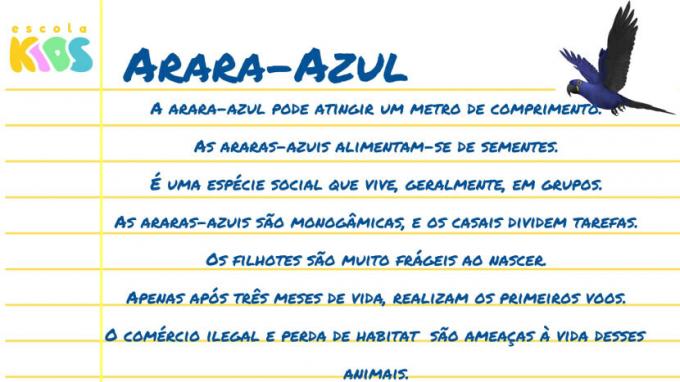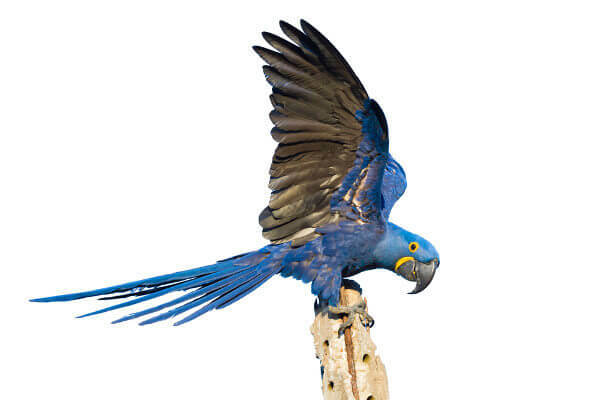Hyacinth macaw is a kind of bird from the parrot family, the same family as parrots and parakeets. The term blue refers to the striking color of this animal, which presents feathers predominantly cobalt blue. In addition to the name hyacinth macaw, this animal is also called black macaw, macaw, great hyacinth macaw and hyacinth macaw.
Read too: Kiwi, a bird from New Zealand
→ Hyacinth macaw taxonomic classification
The Hyacinth Macaw is a species of bird that was first described in 1790 by Latham. Next, we will describe the position of the Hyacinth Macaw in the different taxonomic groups, from the group with the greatest coverage (kingdom) to the one with the smallest coverage (species):
Kingdom: animalia
Phylum: Chordata
Class: birds
Order: psittaciformes
Family: psittacidae
Gender: Anodorhynchus
Species: Anodorhynchus hyacinthinus
→ Hyacinth Macaw Characteristics
Hyacinth macaws stand out for having even a meter in length from the tip of its tail to the tip of its beak. This large size makes the Hyacinth Macaw the largest species in the Psittacidae family. In addition to their length, hyacinth macaws are highlighted by their strong, curved beak, which is specialized in breaking seeds.
Another important point concerns its color: hyacinth macaws have cobalt blue feathers. An interesting detail is that, on the underside of the wing and tail feathers, the color black is observed. In addition to the striking feathers, the yellow tone in some regions of the head of these birds gives this beautiful animal an extra notoriety. You can see the yellow tint around the eyes, on the eyelids, on the skin around the jaw.
→ Hyacinth macaw behavior
Hyacinth macaws are social birds and are usually found in groups, being uncommon to observe solitary individuals. Hyacinth macaw flocks are relatively large, with between 10 and 30 individuals. These flocks are commonly seen in places where they feed and in places called dormitories, which are the places where these animals rest. In some feeding areas, it is common to see hyacinth macaws feeding on seeds that fall to the ground; but they also feed on the seeds directly from the bunch.

Hyacinth macaws are usually found in flocks.
→ Hyacinth Macaw Habitat
Hyacinth macaws are found in the Bolivia, Paraguay and in our country, where it is possible to observe it in the Amazon, Bahia, Goiás, Maranhão, Mato Grosso, Mato Grosso do Sul, Pará, Piauí and Tocantins. In these places, this bird is seen from forest environments to savanna formations. In the Pantanal region, for example, it is common to find them in regions that have palm trees.
→ Hyacinth macaw feeding
Hyacinth macaws basically feed on seed of palm trees. Your ability to ingest this type of food is directly related to strength of its beak, which is able to easily break these seeds. Among the seeds that serve as food for this species of macaw, we can mention those of the acuri, babassu, bocaiuva, buriti, inajá and licuri.
Read too: animal feed

Hyacinth macaws feed on seeds.
→ Hyacinth macaw reproduction
Hyacinth macaws are birds that have some very interesting characteristics when it comes to reproduction. At the time of reproduction, individuals form couples, which are faithful even after the end of that period. Therefore, we can say that the hyacinth macaw is a monogamous species. Hyacinth macaw pairs take care of the nests and their young.
The reproductive phase of these animals begins between seven and nine years of age. The female, after mating, boots one to three eggs and stays in the nest, which can be made in trees or rocky walls, to hatch them. It is worth noting that these eggs are laid on different days.
Until the egg hatches, the female receives food, which is brought in by the male. Incubation lasts between 28 and 30 days, and many of the eggs are lost during this period, being often preyed upon by other birds, such as toucans and some mammals, such as the opossum. Hyacinth macaw nests are generally reused every year.
After being born, the chick remains in the nest for a certain period for him to acquire the ability to fly and feed himself. The puppy is born very fragile, presenting an average of 82 mm and 31 grams. During the first three months, it does not leave the nest, this period being dangerous, as it can be predated or parasitized. Even after it manages to leave the nest and fly, the chick still receives food from its parents for a few months. Generally, the puppy seeks out a young flock after 12 or 18 months.

→ Is the Hyacinth Macaw at risk of extinction?
The hyacinth macaw is currently classified by the IUCN as vulnerable, which means that this species is not yet extinct, but faces a high risk of extinction, if measures are not taken to ensure the survival and reproduction of this species. The biggest threats to the lives of these animals are:
Habitat destruction: a serious problem, as it is in these environments that the hyacinth macaws obtain their food and suitable place for reproduction.
Animal trafficking: another serious threat as many individuals are taken from the wild and sold illegally. According to data from the Arara Azul Institute, until the 1980s, more than 10 thousand hyacinth macaws were removed from their habitat and sold illegally.
Read too:Endangered animals

